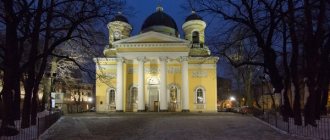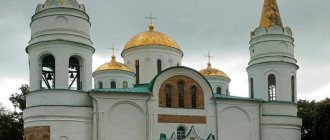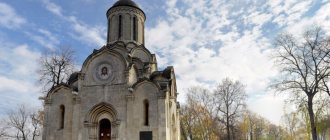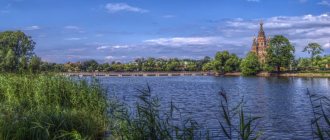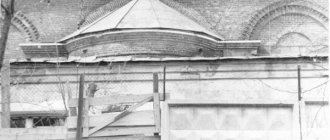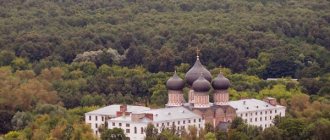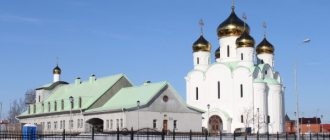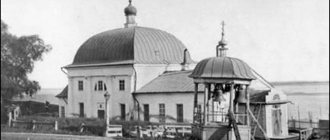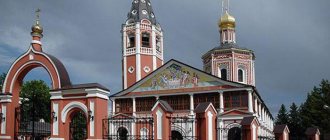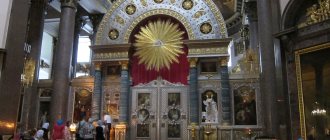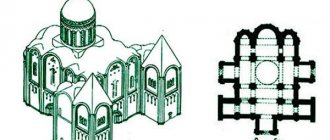The Cathedral of the Transfiguration of the Savior in Rybinsk is one of the most beautiful churches in the city. Its construction lasted a total of 30 years. There is a legend that the author of one of the plans for the temple carried out his rejected project for St. Isaac's Cathedral in St. Petersburg.
Origin of the name and its meaning
On the banks of the Volga there were old wooden churches of Preobrazhenskaya and Petropavlovskaya, where fishermen went to pray for a good catch. After demolition, a stone temple was erected on this site in 1654. The cathedral was named in the name of the Transfiguration of the Lord.
This phenomenon is associated with the fact that Jesus Christ revealed (transformed) his face, that is, his divine appearance, to his three faithful disciples during prayer. In confirmation of this, God himself confirmed the fact of the existence of his son, and commanded everyone present to listen to him as a preacher. Descending from the mountain, Christ warned his disciples about keeping this story silent until his resurrection.
The three chosen ones rejoiced and were amazed at the miracle. After all, none of the living were given the opportunity to see the kingdom of heaven until the end of their earthly days. The Transfiguration of the Lord is one of the great bright holidays. In Christianity, it is customary to name parishes in honor of events from holy scripture. The cathedral in Rybinsk received its name in honor of the Transfiguration of the Lord.
A masterpiece brought to life by necessity
Over time, the number of city residents grew and the question arose about building a more spacious, new city church. The issue, according to the city authorities, could be resolved in two ways. But both involved the destruction of already existing popular buildings in the city.
There was a difficult choice ahead of what to lose: either the old cathedral - a historical value, or the Red Gostiny Dvor, where the main city trade was carried out.
Local residents were divided into two camps: some wanted to preserve the cathedral as a monument to the heritage of their ancestors. Others, interested in trade, did not want to lose the Gostiny Dvor.
It took 20 years to discuss this issue. Finally, the final decision was made, and the old temple began to be dismantled so that a new, spacious cathedral could arise in this place, which could accommodate everyone.
History of the Transfiguration Cathedral
The Transfiguration Cathedral (Rybinsk) was mentioned twice in the chronicles of its urban planning. The first time during construction in the 17th century, the second time in the 19th century. Over the course of two centuries, the stone church had become very dilapidated; its size no longer corresponded to the number of parishioners. The city leadership decided to build a new building.
The dispute over the construction site dragged on for 20 years. At the end of the 17th century, a bell tower was already built, on the western side of which the Red Gostiny Dvor was located, and on the eastern side stood the crumbling building of the old parish. The construction of the cathedral entailed the demolition of the church building or the destruction of the guest house.
Spaso-Preobrazhensky Cathedral (Rybinsk) in the 1830s. Drawing by the Chernetsov brothers.
On July 14, 1838, after serving the last liturgy, the dilapidated building was dismantled, and construction of a new church began in its place. The architect of the project was Mr. A. Melnikov. Construction was financed by local merchants. In 1845, the construction and exterior decoration of the building was completed, and 6 years later its interior decoration was completed.
The buildings of the temple and the bell tower were united by a refectory, which made it possible to perceive the building as a single architectural ensemble. The consecration and opening took place on June 29, 1851. Here the head of the city took the oath, and soldiers going to war received communion. The year 1919 is significant in the history of the cathedral - it was given the title of cathedral.
After the revolution, the temple was closed and was subject to demolition. Servants were disbanded, property was nationalized, valuables were requisitioned. The bells were removed from the belfry.
The Great Patriotic War did not allow the destructive plans to be implemented, but the chapters were sorted out. The building began to be put in order only in the 60s of the last century. They installed a five-domed structure on the cathedral, reconstructed the belfry with a spire and a clock. In 1996, the cathedral was returned to the church, and restoration work was carried out at the beginning of the new millennium.
The temple is a huge cube-shaped building. There are porticoes with columns on four sides, which gives the building the appearance of a cross. Five domes on the hills crown the cathedral: four in the corners and a fifth in the middle.
Due to the height of the dome drums, the building is stretched upward and does not look bulky. The temple and the five-tier bell tower, which is 50 years older than the cathedral, represent a unique historical complex.
To be or not to be?! Be!
During Soviet times, the cathedral was closed.
In December 1929, it was decided to destroy the temple crosses and bells. Only 4 of them were left, the ringing of which was decided to be used to strike the clock. 9 bells were thrown down. To be more sure that they would break, sharp stones were poured onto the flat ground where they were supposed to fall.
An amazing thing happened when they began to throw down the last, largest bell: the Blagovestnik, weighing 16 tons. Having fallen down onto the rocks with a huge roar, he remained intact, only partially going underground.
It took about 2 weeks to continue destroying the bell: it was broken into pieces and taken to Metaltorg.
At the end of the 30s, they planned to build a bridge for cars across the Volga, for this it was necessary to completely destroy the cathedral building. The outbreak of the Great Patriotic War prevented the full implementation of these plans.
But a start had been made for the destruction of the cathedral, and they managed to deprive it of its chapters.
Over the years it was used as a vegetable storehouse, then as a river station building, and later as a theater, circus, and hostel.
In the 60s, according to the second project of the Rybinsk Bridge, it was decided to recreate the cathedral and give it its original, historically magnificent appearance.
Current status of the Transfiguration Cathedral
In the 80s of the 20th century, the question of transferring the Transfiguration Church to the fold of the church began to be raised. In 1989, a Christian parish appeared, the legalization of which occurred only in 1991.
A room was allocated for prayers on the first floor of the belfry. In 1999, the premises of the temple were vacated by the previous owners of the archival fund and transferred to the Yaroslavl and Rostov diocese free of charge.
Divine services at this time were held regularly in the gallery. At the same time, Sunday school began. Thanks to the active position of the governor of the Yaroslavl region A.I. Lisitsin, the Moscow construction corporation “VIT” under the leadership of philanthropist V.I. Tyryshkin was brought in to reconstruct the temple.
The cathedral complex was restored over the course of 4 years. In 2007, the consecration of the revived Transfiguration Cathedral took place in Rybinsk.
For a long time, from 1919 to 1942, the temple had the title of cathedral. During the period of persecution, until 2010, all titles were removed. Now the revived parish has been given back the title of cathedral of the Rybinsk diocese. A charity care center and a Sunday school are opened here. The most beautiful temple on the banks of the Volga is open for prayers and believers.
Where is it, how to get there
Come! The temple is magnificent - both externally and internally! From 7:30 to 19:30 its doors are open to guests every day. The church has 2 addresses: it is located on Cathedral Square, building 1 or on the street. Krestovaya, 2.
From the railway station and from the bus station you can get there by trolleybus or bus, going to the “Cathedral Square” stop.
If you want to learn more about the temple and climb the bell tower, you can book a tour. You just need to do this in advance.
Services are now held regularly in the Transfiguration Cathedral of Rybinsk: in the morning and in the evening. During the daytime, entrance to the temple is open to everyone, including excursion groups.
The church is so huge that it is very difficult to fit it completely into the camera lens. If you want to enjoy the delightful appearance of the temple and take beautiful photos, I recommend moving to the opposite bank of the Volga.
From here the view of the Transfiguration Cathedral in the city of Rybinsk is simply amazing!
Cathedral coordinates: 58.04824, 38.85859. You can find it on the map of Rybinsk.
Well, we go to the historical and architectural museum, which is located very close, on Rybinskaya embankment.
Our trip to Rybinsk took place on July 15, 2016. Other attractions of the Yaroslavl region, where I was able to visit, are on this map.
Share in the comments which cathedrals you have visited and which of them made the most unforgettable impression.
Architecture of the Transfiguration Cathedral
The architectural style of the temple corresponds to late Russian classicism. The massive building is crowned with five domes. Central spherical - in the middle and four in the corners. The vault is supported by arches spanned by strong pillars.
The lower part of the dome has 16 small windows around its circumference, thanks to which the vault is naturally illuminated. In its original form, the sphere was enlivened by 10 soaring angels, but today they are lost.
Four light drums were located in the corners of the building, small domes completed the appearance of the cathedral façade of the roof. All remaining ceilings, including the refectory, are cylindrical in shape. The internal plan of the building consists of a central hall, an altar, side rooms, which have exits to covered galleries with columns and wide staircases.
The walls of the cathedral are decorated with a number of large arched windows. The decoration is the final cornice, vertical projections of the walls and columns of the galleries, and half-windows on light drums. The church domes are crowned with cupolas, the central one has a bypass platform, which gives it a special halo.
The belfry building is made in the Baroque style with individual elements of classicism. The height of the building is about 100 m (in various sources from 94 to 116 m), consists of five levels, the bells are located on the third. Inside the corner abutments there are round rooms with stairs.
The pillars of the bell tower's supports are pushed forward, decorated at the bottom with quadrangular rough stones stacked in a certain sequence. The upper part of the belfry is decorated with slender columns, with a decorated capital, which lengthens the structure, extending it into the sky.
The structure is completed by an octagonal roof. The gilded spire and the eight-pointed cross on it are a unique decoration of the tower.
The Transfiguration Cathedral (Rybinsk) reveals another rare feature, located in the belfry of the temple. Here, in a niche at the very top, in 1896, a clock winding mechanism made by Friedrich Winter in St. Petersburg was installed.
The watch is not electrified; it is wound manually every three days. Every hour, the chimes announce the time by ringing three bells, and a large bell rings for the full hour.
Cathedral bell tower
The bell tower of the chapel rises 94 meters above the ground (the size of 3 nine-story buildings). It is considered the second tallest. Above it is the bell tower of the Peter and Paul Cathedral. The church's belfry won ninth place among 30 Russian bell towers.
From it you can see the surroundings 42 thousand meters ahead. For a long time it served as a fire tower. The monks took up night duty, for which they were paid from the city treasury.
Construction and opening
The belfry was built 50 years before the construction of the temple. Its construction was conceived by Catherine II. The project was created by the self-taught architect Stepan Vorotilov. Unfortunately, he died before the foundation of the bell tower in 1792.
Construction began in 1796. Construction took 7 years.
Semyon Karpov, an ordinary peasant, was able to implement the architect’s plan. On the Feast of the Transfiguration of the Lord in 1804, the bell tower was ready. The bells were raised and installed on it.
Design features
The bell tower is made in a classical style mixed with baroque. Consists of 5 square tiers. They are framed by 52 columns. Each floor has semicircular windows on four sides. There are fences for safety. To get to the top, you need to climb 264 steps.
The very bottom is decorated with rough facing bricks and pilasters - wall projections in the form of columns located on the sides.
On the fifth tier there is a round clock. They were manufactured by Winter's company in 1896. They are wound up every three days by hand.
The roof is octagonal with four slopes, shaped like a hemisphere. The building is crowned with a tall gilded spire. An eight-pointed cross is installed on top of it.
Interior decoration of the Transfiguration Cathedral
Before the destruction, the decoration inside the temple amazed with its beauty and richness. The walls were painted from floor to ceiling, the wooden parts of the iconostasis, the icon cases had gold trim, and valuable icons were kept in the monastery. The period of persecution left nothing of the past greatness.
The interior decoration today is distinguished by grace and purity of color and thought. This is emphasized by the snow-white marble of the wall panels, the decor of the upper parts of the columns, and the unshakable power of the granite slabs on the floor.
A chandelier with candlesticks hangs in the center of the hall. The four-tier iconostasis, assembled for the opening of the temple, and the frescoes at the entrance from Cathedral Square have been restored.
Extensive research work was carried out and the subjects of 37 wall paintings, their authors, and, consequently, the style of the drawings were established. Drawings of frescoes on the transitions to the domed ceiling were also discovered. Preparatory work is underway for the restoration of paintings and frescoes in the interior of the temple.
Shrines of the Transfiguration Cathedral
Miraculous icons and relics of saints are revered by believers. By turning to shrines, you can ask for healing, help, grace for yourself and your loved ones. Relics of this type are located directly in the monasteries.
The Spaso-Preobrazhensky Cathedral (Rybinsk) preserves in it the icons of Saints Fyodor of Sanaksar and Theodore Ushakov with particles of relics. The first was canonized as a locally revered saint for the creation of the Sanaksar monastery and spending 45 years of his life as a monk.
The second was canonized not for his services to the Fatherland, but because he placed Christian ideals at the center of his being and knew how to accept his high military rank with humility.
Believers turn their prayers to the “Watching Eye” icon of the Mother of God and the image of St. Nicholas. The glass display case contains jewelry left by healed people as a token of gratitude.
Particularly revered by parishioners is the grave of the cathedral's rector, Archpriest Rodion Putyatin (1806–1869), in the north side of the bell tower.
Don't miss the most popular article in the section: Metro Nizhny Novgorod. Diagram, map, description.
Grand construction in Rybinsk
Start of construction
A large group of Rybinsk merchants took upon themselves the issue of financing the grandiose construction. But it wasn't all that simple! The hands of the workers did not rise to destroy this ancient, centuries-prayed shrine, left to people from distant ancestors. That main temple of the city, which they had visited with trepidation since childhood.
At the entrance to the old church there was, written directly on the wall and revered by all residents of Rybinsk, the image of the miraculous icon of the Mother of God “Joy of All Who Sorrow.” Since ancient times, this “wall” image has been for Rybinsk residents a symbol of help and consolation in everyday affairs. And now this value had to be destroyed!
To preserve the shrine, a copy was made from the wall image, but this served as little consolation.
And then they cut down part of the wall with the icon, carefully removed it from the masonry and transported it on special rollers to the nearby St. Nicholas Cathedral. But, unfortunately, in the 40s of the 20th century, the St. Nicholas Church was also dismantled, and the shrine was lost forever.
City decoration
In 1845, a new magnificent cathedral arose in the city center, which was connected to the previously built bell tower by a slightly elongated refectory building.
This gave the buildings the appearance of a unified beautiful architectural ensemble. “Beauty of the Volga region”—that’s what contemporaries called this masterpiece of amazing beauty.
Irresistible beauty inside the cathedral!
It cost 194,000 rubles to bring this majestic plan to life. Inside, the cathedral amazed with its splendor and luxury. The walls were made to resemble white marble, and the floor was paved with granite slabs. More than 500 kilograms of gilded silver were used to decorate the interior of the temple and give it a unique uniqueness.
The cathedral was decorated with a wonderful four-tiered iconostasis with ancient icons. The ancient temple icon of the Transfiguration of the Lord was especially revered. There are reliable facts that Moscow Old Believers offered to give 30,000 rubles for it. But, of course, neither the city residents nor the clergy agreed to this.
An indelible impression on those present was made by the moment of the evening service, when the Royal Doors of the main iconostasis opened. The sight of the Holy Throne, illuminated by 8 lamps and three candlesticks, evoked an exclamation of admiration!
The majestic chandelier - the central chandelier of the temple, consisting of 3 tiers - was donated to the beautiful cathedral by the merchant I. Krupyshev. It weighed 800 kg and was a luxurious bush in which 105 candles supported gilded figurines of angels with wings. It must have been a fantastic sight!
And in the very center stood a city relic: a luxurious throne-chair under a velvet canopy, made especially for Catherine II, who visited the city in 1767.
Later, a shelter for the poor and a parish school began to exist at the cathedral.
Interesting facts and legends
The author of the project of the Transfiguration Cathedral was St. Petersburg resident A.I. Melnikov. Tradition indicates that this project participated in a competition held in St. Petersburg for the construction of St. Isaac's Cathedral, but was a fiasco and lost.
They say that during the period of desecration of holy churches and the ban on bell ringing in 1929, all the bells from the Rybinsk bell tower were thrown down and melted down. According to legend, the large bell did not break and was put back in its place.
But according to other sources, Blagovest was not removed, but was left for the chiming clock. Be that as it may, the Great Bell of antiquity is still in the bell tower, participates in church chimes and regularly strikes the time.
Organization of pilgrimage trips
A pilgrimage department was created in Yaroslavl. It is located at the address Yaroslavl, Bogoyavlenskaya Square, 4. Telephone. The department is open from 10 to 17 on weekdays; twelve holidays; The first week of Great Lent is days of rest.
Pilgrims are offered the following program:
- Divine Liturgy.
- Procession to the monument to Theodore Ushakov.
- Meeting of the relics.
- Procession to the Transfiguration Cathedral.
- Prayer service and veneration of the relics of the righteous warrior Theodore Ushakov.
- Excursion to Orthodox churches in the city of Rybinsk.
You can also visit the cathedral privately; entry is always free. If you want to take a guided tour of the temple, you should arrange this in advance. The tour for up to 25 people is organized and includes a visit to the bell tower. Photo and video filming is permitted.
Schedule of services
Divine services and sacraments are held according to the following schedule:
| confession | at 8:30 on Sundays |
| morning Divine Liturgy | at 6:15 (Sundays), at 8:00 (weekdays) |
| evening service | at 17:00 (on weekdays and weekends) |
| blessing of water | by 8am on Sundays |
The duration of service is up to 3 hours. For those who have difficulty on their feet during the service, you can sit on the benches. It is permissible to leave the temple before the end of the prayer, provided that this does not disturb anyone. According to Christian tradition, women entering the temple cover their heads, shoulders and legs. Men, on the contrary, take off their headdress.
The Cathedral Church of the Transfiguration of the Savior is central and ancient in Rybinsk. Currently, an embankment has been built near the building, and external lighting has been installed on the walls of the complex. All this emphasizes the beauty and grandeur of the temple ensemble. A visit to the temple brings aesthetic pleasure, a feeling of touching history and the spirit of Christianity.
Author: Marie Arkhipova
Article design: Mila Friedan
